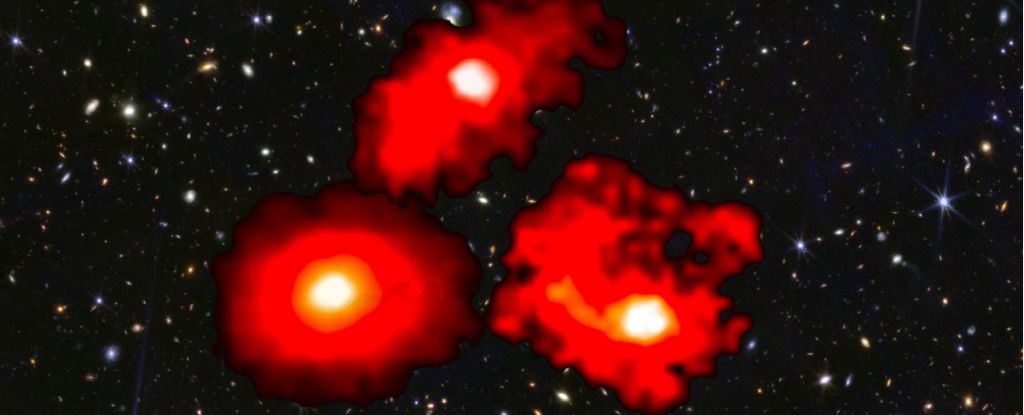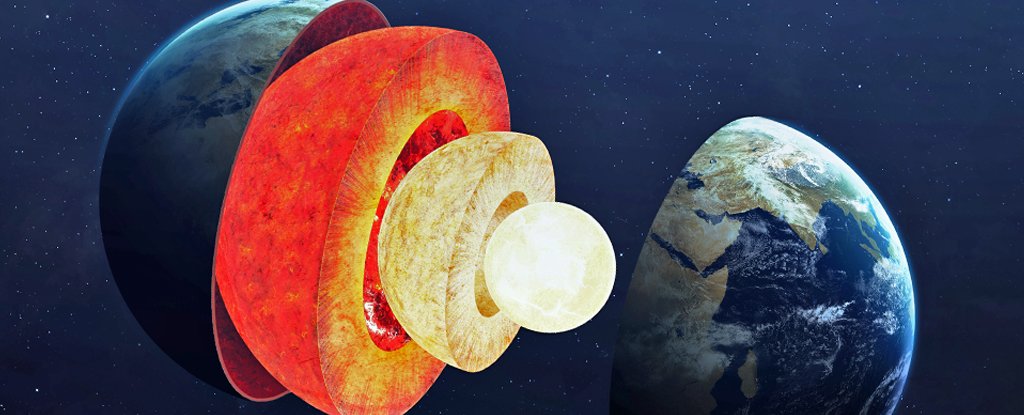In the early Universe, long before they should have had time to grow, astronomers have found what they’re calling ‘red monsters’: three large galaxies, almost as big as the Milky Way.
It’s a challenging discovery for several reasons – not least of which is the contradiction it poses to our understanding of how galaxies formed, back when time and space were mewling newborns in the void.
“The question of ‘impossibly’ massive galaxies shortly after the Big Bang has vexed astronomers ever since the first images of the James Webb Space Telescope,” says astronomer Ivo Labbé of Swinburne University of Technology.
“This is akin to finding a toddler weighing 100 kilograms. JWST has now proven monsters do roam the early Universe.”
Based on careful observation and analysis, we have a pretty good idea about how many cosmic processes unfold. But one crucial time period eludes us: the early Universe, known as the Cosmic Dawn, the first billion years following the Big Bang.
frameborder=”0″ allow=”accelerometer; autoplay; clipboard-write; encrypted-media; gyroscope; picture-in-picture; web-share” referrerpolicy=”strict-origin-when-cross-origin” allowfullscreen>
We have some ideas about how fast the Universe assembled itself from the primordial plasma that permeated the early cosmos, but observational evidence has been a little harder to obtain. With the advent of JWST, we’ve been able to collect that evidence. As the far reaches of space recede, the light from objects within is stretched to the infrared wavelengths with which the powerful space telescope views the Universe, giving us the strongest probe yet for the Cosmic Dawn.
According to our models, galaxies take some time to assemble and grow. We’re not entirely sure of the particulars, but the most popular model involves blobs of dark matter, into which baryonic (or normal) matter is gravitationally collected. As more and more baryonic matter accumulates, it starts to coalesce into stars, swirling around a giant black hole in the galactic center.
Although galaxies appear pretty quickly after the Big Bang, the rate at which they grow was thought too slow for massive galaxies to emerge during the Cosmic Dawn. So, when JWST turned its golden eye towards the early Universe, and started seeing signs of larger-than-expected galaxies there, astronomers and cosmologists were perplexed.
One potential explanation offered earlier this year is that those over-large galaxies are not as big as they look; the light emitted from material around their central black holes is just very bright, making the galaxies appear bigger than they are. And a recent discovery revealed that black holes can, for brief periods, illuminate their galaxies to very high brightness.
This may be the case for some of the galaxies. But the new research, led by astronomer Mengyuan Xiao of the University of Geneva in Switzerland, shows that, in at least some cases, when it looks like a massive galaxy and quacks like a massive galaxy, it is indeed a massive galaxy.
frameborder=”0″ allow=”accelerometer; autoplay; clipboard-write; encrypted-media; gyroscope; picture-in-picture; web-share” referrerpolicy=”strict-origin-when-cross-origin” allowfullscreen>
The observations were conducted for JWST’s FRESCO program, an international collaboration to obtain accurate distance and mass measurements for galaxies in the early Universe. Most of the galaxies the team studied fit the existing models for galaxy evolution, but three really stood out as abnormal.
Each of these red monsters was nearly the size of the Milky Way. None of them actually contradicts the current cosmological model, nor the leading theory for dark matter; but they do suggest that the galaxies are converting baryonic matter into stars at a rate two to three times higher than the most efficient star-forming galaxies later in more recent epochs of the Universe.
But the galaxies do challenge our understanding of the rate at which stars can form. If a galaxy is very active, it should contain a high rate of feedback – forces that push star-forming material away, limiting the rate at which new stars can form. So, unsurprisingly it appears that there is something that we don’t know.
“Current models fail to explain how it is possible star formation is so super-efficient, very early in the Universe,” Labbé says.
“The usual assumption is that exploding stars and supermassive black holes kill star formation, blowing out the candle. No doubt future Webb observations will provide us clues as to what we are missing.”
The team’s findings have been published in Nature.





